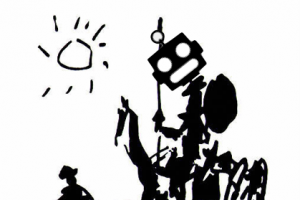|
JetEdit is designed to exponentially accelerate the time it takes filmmakers to go from shooting footage to a rough cut by leveraging their impressions of takes while filming, and using that semantic data to generate a rough cut instantly.  |
Many types of investigators routinely perform analysis that involves large collections of documents. The Jigsaw system helps investigative analysts with reasoning and sense-making in such scenarios. Jigsaw acts like a visual index onto a document collection. It first analyzes the documents, identifies entities, clusters related documents, analyzes sentiment, and summarizes each document. Next, it provides multiple visualizations of the documents, entities within, and the analysis results.  |
Jill Watson and AskJill are AI-powered Q&A agents. Jill Watson, currently deployed in four classes, serves as a virtual TA that answers student questions related to course syllabus and schedule. It's goal is to enhance teacher presence in the class. AskJill, evolved from Jill Watson, is an artificial intelligence explanation agent that can answer questions about the domain, operation and functionality of other AI systems as outlined in their user guides. It is currently deployed in an AI-based interactive learning environment VERA (Virtual Ecological Research Assistant).  |
How do you making waiting around less tedious? We’ve partnered with the Georgia Aquarium to find a way to help build the excitement for the Dolphin Celebration shows. Our solution tells guests the story and capabilities of dolphins, from which we are prototyping a single chapter that focuses on the wonders of echolocation. This project shows the designs of five interactive modules, called “chapters.” Each teaches elements of dolphin behavior and interactions with their natural environment. |
|
Given the importance of developers for the success of mobile platforms, it is critical for vendors to understand how platform innovations impact developer interaction activity and what issues and topics are discussed. An understanding of these issues can help providers improve their release strategies, manage developer expectations, and avoid negative reputation effects. To facilitate this understanding, we are analyzing knowledge ecosystem reactions to change in mobile software development platforms.  |
We present KnowledgeVIS, a visual analytics tool in your browser for exploring and browsing relationships that language models (LMs) have learned by identifying, comparing, and summarizing LM predictions Website: |
While there is a growing focus on leveraging technology use for learning gains across the world, this focus is yet to extend to infrastructurally limited environments in India, among other countries. We draw on qualitative research conducted in the Indian states of Tamil Nadu, Maharashtra, and West Bengal to highlight the challenges of designing educational technologies for "low-resource'' contexts, particularly when they are "low-resource'' along different dimensions. |
The Quixote system is an artificial intelligence technique for teaching robots and artificial virtual agents how to do things by telling them stories. Stories present a natural means of communicating complicated, tacit procedural knowledge. Quixote thus reads in natural language stories and learns to emulate the behaviors of the characters in the stories. The long term goal of the project is to make AI programming accessible to non-programmers and non-AI experts. We have also shown that stories can be an effective means of demonstrating ethical behavior to robots and AIs.  |
|
We conduct 3 in-lab and one crowd-sourced experiment in the domains of politics and movies. We find mixed results that interaction traces (visual scents of historical interactions) can increase awareness of bias and impact interactive behavior and decision making.  |
Why is it so hard for chatbots to talk about race? This work explores how the biased contents of databases, the syntactic focus of natural language processing, and the opaque nature of deep learning algorithms cause chatbots difficulty in handling race-talk. In each of these areas, the tensions between race and chatbots create new opportunities for people and machines. By making the abstract and disparate qualities of this problem space tangible, we can develop chatbots that are more capable of handling race-talk in its many forms. |
There are hundreds and thousands of professional conferences across the globe. While a lot of people come to seek new insights, learn and present, a huge chunk of people also look for networking opportunities with other attendees. However, initial discoveries were made that actually, there are some gaps in how attendees network with others especially before and after the conferences.  |
Business analysts create logomaps in order to better understand and communicate trends in the world of business. Humans can intuitively make sense of these maps, while computers struggle to extract the same knowledge. Using computer vision and human-in-the-loop machine learning, this research aims to create tools and methods for automating knowledge extraction from graphical logomaps.  |
|
Lonely Mountain is a virtual reality adaptation of the movie The Hobbit: The Battle of the Five Armies. In this VR experience, Lonely Mountain has fallen into the claws of Smaug the Terrible. You will take the role of the Hobbit, Bilbo Baggins. Your mission is to find and recover the Arkenstone, and unite the dwarf realms once more under the same banner to save Lonley Mountain. The scenario has Bilbo reaches the treasure room and picks up a tool to grab the Arkenstone from the claws of Smaug without waking up Smaug.  |
This research investigated whether providing directional alerts to a user's active screen can augment their ability in regaining situational awareness when traveling in an autonomous vehicle (AV). |


